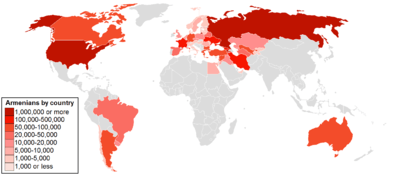Armenians in Russia
| Total population | |
|---|---|
|
1,182,388 (2010 census)[1] 2,000,000[2]—2,500,000 (estimates)[3] 0.8%-1.7% of the Russian population | |
| Regions with significant populations | |
| Moscow, Krasnodar Krai, Stavropol Krai, Rostov Oblast | |
| Languages | |
| Russian, Armenian (mostly Eastern Armenian) | |
| Religion | |
| Christianity (predominantly Armenian Apostolic)[4][5] |
Armenians in Russia or Russian Armenians[n 1] are one of the country's largest ethnic minorities and the largest Armenian diaspora community outside Armenia. The 2010 Russian census recorded 1,182,388 Armenians in the country. Various figures estimate that the ethnic Armenian population in Russia is actually more than 2 million. Armenians populate various regions, including Moscow, Saint Petersburg, Krasnodar Krai in the North Caucasus and as far as Vladivostok in the East.
History
Early period
There has been an Armenian presence in Russia since the Late Middle Ages, when various artisans, merchants and traders ventured north to the Crimea and the northern Caucasus in order to set up trade ties and conduct commerce.
Russian Empire
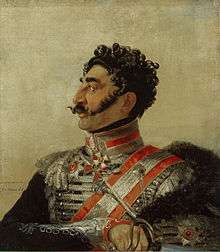
A significant number of Armenians were already living in the Russian Empire before the 1820s. After the destruction of the last remaining independent Armenian states in the Middle Ages, the nobility disintegrated, leaving Armenian society composed of a mass of peasants plus a middle class who were either craftsmen or merchants. Such Armenians were to be found in most towns of Transcaucasia; indeed, at the beginning of the 19th century they formed the majority of the population in cities such as Tbilisi. Armenian merchants conducted their trade across the world and many had set up base within Russia. In 1778, Catherine the Great invited Armenian merchants from the Crimea to Russia and they established a settlement at Nor Nakhichevan near Rostov-on-Don.[6] The Russian ruling classes welcomed the Armenians' entrepreneurial skills as a boost to the economy, but they also regarded them with some suspicion. The image of the Armenian as a "wily merchant" was already widespread. Russian nobles derived their income from their estates worked by serfs and, with their aristocratic distaste for engaging in business, they had little understanding or sympathy for the way of life of mercantile Armenians.
Nevertheless, middle-class Armenians prospered under Russian rule and they were the first to seize the new opportunities and transform themselves into a prosperous bourgeoisie when capitalism and industrialisation came to Transcaucasia in the later half of the 19th century. The Armenians were much more skilled at adapting to the new economic circumstances than their neighbours in Transcaucasia, the Georgians and the Azeris. They became the most powerful element in the municipal life of Tbilisi, the city regarded by Georgians as their capital, and in the late 19th century they began to buy up the lands of the Georgian nobility, who had gone into decline after the emancipation of their serfs. Armenian entrepreneurs were quick to exploit the oil boom which began in Transcaucasia in the 1870s, having large investments in the oil-fields in Baku in Azerbaijan and the refineries of Batumi on the Black Sea coast. All this meant that the tensions between Armenians, Georgians and Azeris in Russian Transcaucasia were not simply ethnic or religious in nature but were due to social and economic factors too. Nevertheless, in spite of the popular image of the typical Armenian as a successful businessman, at the end of the 19th century 80 per cent of Russian Armenians were still peasants working the land.[7]
Soviet Russia
According to the Union of Russian Armenians, there are 2.5 million Armenians living in Russia today. According to the same source, about 850,000 are immigrants from Armenia, 350,000 from Azerbaijan and 250,000 from Georgia, including 100,000 from Abkhazia and 180,000 from Central Asia, mostly Tajikistan and Turkmenistan.[8]
The Russian government is encouraging Armenians to immigrate and settle in Russia and is providing financial and settlement incentives.[9]
Armenians in Russia have one of the highest rates of educational attainment. According to the 2002 census 21.4% of Armenians have higher education, 31.8% have "middle special" education (i.e. vocational education), and 46.1% have secondary education.[10]
Distribution
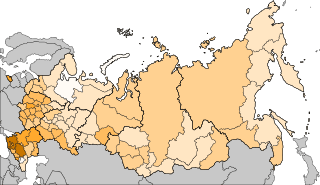

| Rank | Federal subject | 1897 | 1959[11] | 1970[12] | 1979[13] | 1989[14] | 2002[15] | 2010[1] |
|---|---|---|---|---|---|---|---|---|
| 1 | Krasnodar Krai | 13,926[16] | 78,176 | 98,589 | 120,797 | 182,217 | 274,566 | 281,680 |
| 2 | Stavropol Krai | 5,385[17] | 25,618 | 31,096 | 40,504 | 72,530 | 149,249 | 161,324 |
| 3 | City of Moscow | 1,604[18] | 18,379 | 25,584 | 31,414 | 43,989 | 124,425 | 106,466 |
| 4 | Rostov Oblast | 27,234[19] | 49,305 | 53,620 | 56,902 | 62,603 | 109,994 | 110,727 |
| 5 | Moscow Oblast | N/A | 5,353 | 5,683 | 7,549 | 9,245 | 39,660 | 63,306 |
| 6 | Volgograd Oblast | N/A | N/A | 2,898 | 4,229 | 6,784 | 26,974 | 27,846 |
| 7 | Saratov Oblast | 168[20] | 1,046 | 1,815 | 3,531 | 6,404 | 24,976 | 23,841 |
| 8 | Samara Oblast | N/A | 1,027 | 1,629 | 2,216 | 4,162 | 21,566 | 22,981 |
| 9 | City of Saint-Petersburg | 753[21] | 4,897 | 6,628 | 7,995 | 12,070 | 19,164 | 19,971 |
| 10 | North Ossetia | 2,093[22] | 12,012 | 13,355 | 12,912 | 13,619 | 17,147 | 16,235 |
| 11 | Adygea | N/A | 3,013 | 5,217 | 6,359 | 10,460 | 15,268 | 15,561 |
Moscow

The 2010 Russian census put the number of Moscow Armenians at 106,466. Another 63,306 Armenians lived in Moscow region at the time. There are various estimates on the number of Armenians in Moscow: 400,000,[23] 600,000,[24] 1,000,000.[25][26] Moscow is often regarded as the largest Armenian community outside Armenia.
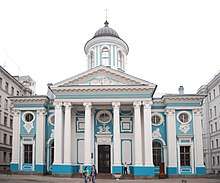
Saint Petersburg
In 1708 the first Armenians came to St. Petersburg, and in 1710 in the city already existed “Armenian offices”. In 1730, under the leadership of the priest Ivan Sheristanova organized the first parish of the Armenian Apostolic Church. Throughout the 20th century Armenian population of St. Petersburg has been steadily increasing. The number of Armenians in St. Petersburg increased from 1,759 in 1926 to 19,164[15] in 2002.
According to Soviet 1989 census 47% Armenians speak Armenian as native language, 52% speak Russian as native language. At the same time almost all fluent in Russian language. About half of the Armenians have higher education and, consequently, higher social status.[27]
According to the head of Saint Petersburg's Armenian community Karen Mkrtchyan, currently about 100,000 Armenians are living in the region of Saint Petersburg. There are 2 Armenian churches, a Sunday school, "Havatamk" Armenian monthly and a printing house.[28]
Krasnodar
The Krasnodar Krai is one of the biggest communities of the Armenian diaspora.[29] According to the Russian 2002 census, there were 274,566 Armenians. 211,397 of them spoke Armenian as their native language and 6,948 had Armenian citizenship.
According to estimates some 500,000,[30][31] 700,000[32] or 1,000,000[33] Armenians resided in Krasnodar.
They are chiefly concentrated in Greater Sochi (80,045[34]–125,000)[35] the city of Krasnodar (28,022[n 2]–70,000),[37] the city of Armavir (18,262[36]–50,000)[38] Tuapse (18,194)[n 3], Novorossiysk (12,092[36]–40,000)[39] Apsheron (10,659),[36] and Anapa (8,201).[36]
Rostov on Don
Historically, the Don region was home to the largest Armenian community on the territory of the modern Russian Federation. Armenians were resettled from Crimean Khanate in 1779 by orders of Catherine the Great and founded several settlements around the territory of modern Rostov-on-Don. The largest of them, Nakhichevan-on-Don, was merged into the Rostov city in 1928. Armenians still constitute the majority of Myasnikovsky District population. In 2010 Rostov-on-Don had the third largest Armenian population of all Russian cities (after Moscow and Sochi, Krasnodar Krai).
Notable Russian Armenians

Arts and entertainment
- Ivan Aivazovsky (1817–1900), painter
- Irina Allegrova (b. 1952), pop singer
- Artsvik (b. 1984), pop singer
- Arno Babajanian (1921–1983), composer and pianist
- Armen Dzhigarkhanyan (b. 1935), actor
- Sergey Galoyan (b. 1981), music producer
- Mikhail Galustyan (b. 1979), comedian and showman
- Armen Grigoryan (b. 1960), singer songwriter
- Luara Hayrapetyan (b. 1997), singer-songwriter
- Artur Janibekyan (b. 1976), co-producer of Comedy Club
- Edmond Keosayan (1936–1994), film director
- Aram Khachaturian (1903–1978), classical composer
- Dmitry Kharatyan (b. 1960), actor
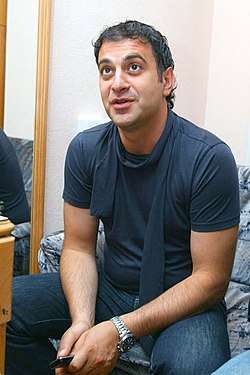 Garik Martirosyan, comedian, co-producer of Comedy Club
Garik Martirosyan, comedian, co-producer of Comedy Club - Garik Martirosyan (b. 1974), comedian, co-producer of Comedy Club
- Frunzik Mkrtchyan (1930–1993), actor
- Stas Namin (b. 1951), rock singer
- Levon Oganezov, pianist and conductor
- Sergei Parajanov (1924–1990), film director and artist
- Yevgeny Petrosyan (b. 1945), comedian (father's side)
- Eva Rivas (b. 1987), pop singer (mother's side)
- Avraam Russo (b. 1969), pop singer
- Igor Sarukhanov (b. 1956), rock singer
- Martiros Saryan (1880–1972), painter
- Karen Shakhnazarov (b. 1952), filmmaker, producer, director of Mosfilm since 1998
- Mikael Tariverdiev (1931–1996), composer
- Agrippina Vaganova (1879 – 1951), ballet teacher
- Yevgeny Vakhtangov (1883–1922), actor and theatre director
- Lousine Gevorkyan (b. 1982), rock singer
Politics and military
.jpg)

- Sergei Avakyants (b. 1957), admiral, commander of the Pacific Fleet
- Hamazasp Babadzhanian (1906–1977), Chief Marshal of the Mechanized Forces of the USSR, hero of USSR
- Ivan Bagramyan (1897–1982), Marshal of the Soviet Union
- Vasili Bebutov (1791–1858), Adjutant General of the H.I.M. Retinue, General of the Infantry
- Ivan Isakov (1894–1967), military commander, Chief of Staff of the Soviet Navy, Deputy USSR Navy Minister, held the rank of Admiral of the Fleet of the Soviet Union
- Sergei Khudyakov (1902–1950), Marshal of Aviation
- Ivan Lazarev (1820–1879), general
- Sergey Lavrov (b. 1950), Foreign Minister of Russia since 2004 (father's side)
- Mikhail Loris-Melikov (1825–1888), General of the Cavalry, Minister of Interior of Russia in 1880–1881
- Valerian Madatov (1782–1829), prince, a lieutenant-general of the Russian Empire
- Anastas Mikoyan (1895–1978), Soviet statesman and diplomat, First Deputy Chairman of the Council of Ministers of the Soviet Union (second highest figure in the Soviet Union) from 1955 to 1964
- Artem Mikoyan (1905–1970), brother of Anastas, aircraft designer, designed many of the famous MiG military aircraft
- Movses Silikyan (1862–1937), Major General in the Russian Imperial Army
- Nelson Stepanyan (1913–1944), two times hero of USSR, dive bomber pilot during WWII
Scientists
- Sergei Adian (b. 1931), prominent mathematician[40]
- Tateos Agekian (1913–2006), astrophysicist, a pioneer of stellar dynamics
- Abraham Alikhanov (1904–1970), Soviet physicist, a founder of nuclear physics in USSR
- Gurgen Askaryan (1928–1997), physicist, inventor of light self focusing
- Boris Babaian (b. 1933), the father of supercomputing in the former Soviet Union and Russia
- Mikhail Chailakhyan (1902–1991), founder of hormonal theory of plant development
- Artur Chilingarov (b. 1939), polar explorer, member of the State Duma from 1993 to 2011
- Andronik Iosifyan (1905–1993), scientist and inventor, the father of electromechanics in the USSR
- Alexander Kemurdzhian (1921–2003), designer of the first rovers to explore another world: first moon rovers and first Mars rovers
- Semyon Kirlian (1898–1978), founder of Kirlian photography; discovered that living matter is emitting energy fields
- Ivan Knuniants (1906–1990), chemist, a major developer of the Soviet chemical weapons program
- Yuri Oganessian (b. 1933), nuclear physicist, the world's leading researcher in superheavy elements
- Leon Orbeli (1882–1958), founder of evolutionary physiology
- Norair Sisakian (1907–1966), a founder of space biology; pioneer in biochemistry of sub-cell structures and technical biochemistry
Sports

- Grigory Mkrtichyan (b.1925), hockey player and coach, 1956 Olympic champion
- Artur Dalaloyan (b.1996), artistic gymnast
- Arsen Galstyan (b. 1989), judoka, 2012 Olympic champion
- Margarita Gasparyan (b. 1994), singles tennis player (father's side)
- Karen Khachanov, (b. 1996), singles tennis player
- Evgenia Medvedeva (b. 1999), 2018 Olympic silver medalist, 2 time World Champion, ladies' singles figure skater (father's side)
- Nikita Simonyan (b. 1926), football player and coach
- Seda Tutkhalyan (b. 1999), artistic gymnast, 2016 Olympic team silver medalist
- Yana Egorian (b.1993), 2016 Olympic Champion in women's individual sabre
- Artur Danielian (b.2003), 2018 World Junior silver medalist, men's singles figure skater
Miscellaneous
- Ara Abrahamyan (b. 1957), businessman
- Ruben Dishdishyan (b. 1959), entrepreneur
- Garry Kasparov (b. 1963), chess grandmaster, writer and political activist, considered by many to be the greatest chess player of all time
- Margarita Simonyan (b. 1980), journalist, editor-in-chief of the television news network RT
- Ruben Vardanian (b. 1968), businessman, CEO of Troika Dialog
See also
References
- Notes
- ↑ Note that this article is about the Armenians living within Russia's current borders. Through large parts of the 19th and almost the entire 20th century, part of the Armenian homeland (known as Russian Armenia or Eastern Armenia) was under Russian and later Soviet rule. For Armenians in countries that have been part of Russia in the past, see Armenians in Azerbaijan, Armenians in Georgia, Armenians in Ukraine, Armenians in Belarus, Armenians in Moldova, Armenians in the Baltic states, Armenians in Central Asia and Armenians in Poland.
- ↑ 21,390 in the city itself and 6,632 in the municipality[36]
- ↑ 5,335 in the city itself and 12,859 in the district[36]
- References
- 1 2 (in Russian) Национальный состав населения по субъектам Российской Федерации
- ↑ Harutyunyan 2010, p. 129.
- ↑ В России проживает более 2,5 млн армян [2,5 million Armenians live in Russia] (in Russian). RIA Novosti. 16 December 2002. Retrieved 5 January 2013.
- ↑ Arena - Atlas of Religions and Nationalities in Russia. Sreda.org
- ↑ "Арена в PDF : Некоммерческая Исследовательская Служба "Среда"". Sreda.org. Retrieved 2014-04-20.
- ↑ Suny. Armenian People, p. 110
- ↑ See Suny Chapter 2 "Images of Armenians in the Russian Empire" in Looking Toward Ararat: Armenia in Modern History. Bloomington: Indiana University Press, 1993 ISBN 0-253-20773-8
- ↑ В России проживает более 2,5 млн армян (in Russian). РИА "Новости". December 16, 2002. Retrieved July 21, 2012.
- ↑ "Armenia Urges Russia to Discourage Armenian Migration". Asbarez.com. Retrieved 2 May 2016.
- ↑ "Народы России. Атлас культур и религий". Retrieved 2 May 2016.
- ↑ "Демоскоп Weekly - Приложение. Справочник статистических показателей". Retrieved 2 May 2016.
- ↑ "Демоскоп Weekly - Приложение. Справочник статистических показателей". Retrieved 2 May 2016.
- ↑ "Демоскоп Weekly - Приложение. Справочник статистических показателей". Retrieved 2 May 2016.
- ↑ "Демоскоп Weekly - Приложение. Справочник статистических показателей". Retrieved 2 May 2016.
- 1 2 National composition of population for regions of the Russian Federation Archived 2007-02-17 at the Wayback Machine.
- ↑ (in Russian) Кубанская область
- ↑ (in Russian) Ставропольская губерния
- ↑ (in Russian) Московская губерния
- ↑ (in Russian) Облась Войска Донского
- ↑ (in Russian) Саратовская губерния
- ↑ (in Russian) г. Санкт-Петербург
- ↑ (in Russian) Терская область - Владикавказский округ
- ↑ (in Russian) В России армян "обласкали и дали им охоту"
- ↑ (in Russian) В России проживает более 2,5 млн армян
- ↑ (in Russian) Сколько русских осталось в Москве?
- ↑ Armenian population in the world Archived May 11, 2013, at the Wayback Machine.
- ↑ "Бизнес Санкт - Петербурга - Информация о организации". Retrieved 2 May 2016.
- ↑ Տերտերյանը "վերադարձավ" Հայրավանք // Havatamk, #8, 2015, p. 6, by Samvel Danielyan
- ↑ "АРМЯНЕ КРАСНОДАРСКОГО КРАЯ В КОНТЕКСТЕ СОВРЕМЕННОЙ МИГРАЦИОННОЙ СИТУАЦИИ. по Михаил Савва, "Нораванк"" (PDF). noravank.am. Retrieved 21 April 2018.
- ↑ Savva, Mikhail (2007). "Армяне Краснодарского края в контексте современной миграционной ситуации [Krasnodar Krai Armenians in the context of the recent migration situation]" (PDF) (in Russian). Noravank Foundation. Retrieved 2 May 2013.
- ↑ Կրասնոդարի երկրամասում 500 հազար հայ է բնակվում. Armenpress (in Armenian). 20 January 2003. Retrieved 30 September 2013.
- ↑ Կրասնոդարի հայերի գլխավոր խնդիրը հայապահպանությունն է, ասում է համայնքի ղեկավարը. PanARMENIAN.Net (in Armenian). 8 June 2012. Retrieved 30 September 2013.
- ↑ "В России проживает более 2,5 млн армян [Over 2.5 million Armenians live in Russia]" (in Russian). RIA Novosti. 15 December 2003. Retrieved 2 May 2013.
- ↑ Сочинская Городская Администрация (2002 г.) (in Russian). Retrieved 30 September 2013.
- ↑ Schreck, Carl (5 May 2006). "Sochi's Armenian Diaspora Weeps". The Moscow Times. Archived from the original on 30 May 2014.
With 125,000 ethnic Armenians in Sochi, out of a total of 400,000 people...
- 1 2 3 4 5 6 (in Russian) НАСЕЛЕНИЕ КРАСНОДАРСКОГО КРАЯ
- ↑ Коновалова, Евгения (February 12, 2007). Армяне на Кубани: мигранты или местные жители? (in Russian). ЮГА.ру. Retrieved July 19, 2012.
- ↑ "People speak Armenian in Armavir". A1plus. January 25, 2011. Retrieved July 19, 2012.
- ↑ (in Russian) Армянское культурное общество «Луйс»
- ↑ http://people.cs.uchicago.edu/~razborov/files/adian75.pdf
Bibliography
- Harutyunyan, Yuri (2010). Об этносоциологических исследованиях армян России. Patma-Banasirakan Handes (in Russian) (1): 129–136.
